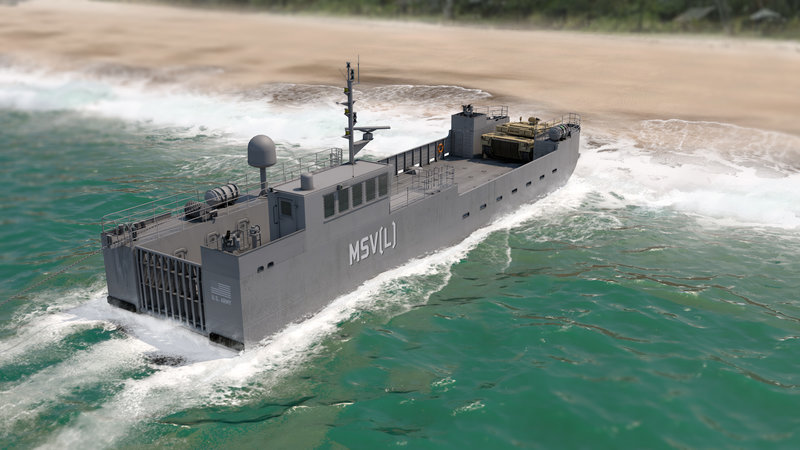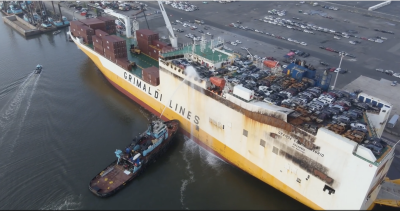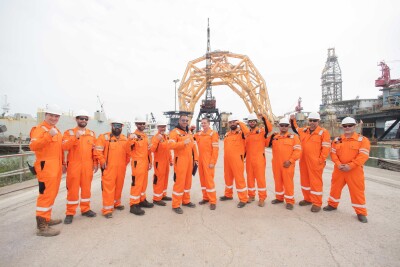The U.S. Army has awarded Vigor a contract to build its new generation of landing craft. The contract is the largest award in Vigor’s history, valued at $979 million over a 10-year period. It will provide employment for roughly 200 skilled workers.
The Vigor maneuver support vessel light (MSV(L)) design was developed in partnership with Alexandria, Va.-based BMT Designers & Planners following a detailed study of the Army’s unique needs. It dramatically improves the capabilities of the current landing craft mechanized/mechanical (LCM-8) and provides the optimal combination of performance, operational flexibility and lifecycle cost while maintaining the reliability and versatility of the Army’s current craft.
The landing craft’s tribow monohull is an innovative yet deceptively simple design that provides superior maneuverability and stability in high sea states, through the littorals and within inland waterways in support of land-based operations, Vigor said in a press release.
The award comes concurrent with a "Milestone B" decision that moves the program into its engineering and manufacturing development phase. Over the next four years, the Army will work with Vigor Works LLC, Clackamas, Ore., as it produces a full-scale prototype for additional evaluation and to develop the program's final requirements. A "Milestone C" decision and authorization for low rate initial production of the first four vessels is scheduled for the end of fiscal year 2021, followed by a full-rate production decision in fiscal year 2023. The Army seeks to buy 36 total vessels for use by Army mariners around the world.
“This award is the culmination of a five-year process of research and development that first began with Kvichak prior to its merger with Vigor,” Frank Foti, Vigor CEO, said in the prepared statement. “We are grateful for the exceptional work done by our entire team and honored to have been selected to serve the Army in this important project.”
Vigor’s team currently consists of a number of key partners including BMT, Gladding-Hearn and Northrop Grumman.
“Phase one of the program will begin immediately and center on design refinement and prototype construction,” Tim Kolb, general manager of Vigor Ballard who spearheaded the proposal process, said. “The contract calls for one prototype vessel, four vessels under low rate production, and up to 32 additional vessels.”
"The range of operating environments our soldiers face today — and will face in the future — continues to grow more diverse," Brig. Gen. Jeffrey Drushal, U.S. Army chief of transportation, said in an Army release. "Our mariners need modern, capable vessels that can carry today's soldiers and equipment. Our commanders need the flexibility to maneuver in many different environments — including maneuvering from the sea. This vessel will do both and provide a critical advantage in future operations."
As the first new Army watercraft in decades, the maneuver support vessel (light) will displace the Army's fleet of Vietnam-era landing craft mechanized (LCM-8) boats with a modern capability, giving commanders significantly improved seaborne maneuver flexibility. The MSV(L) will provide intra-theater transportation of personnel and materiel, delivering cargo from advanced bases and deep-draft strategic sealift ships to harbors, inland waterways, remote and unimproved beaches and coastlines, and denied or degraded ports.
"Army transportation investments over the last decade rightly prioritized vehicle capabilities, especially in the area of protection," Col. Dan Furber, project manager, transportation systems, said in the Army release. "While that was the right thing to do, it also deferred investment in the watercraft fleet and created a mismatch between the size and weight of ground systems and the watercraft designed to carry them. MSV(L) will restore operational relevance to the Army watercraft fleet at an important time."
Most importantly, the program will restore the Army's ability to carry the weight of modern combat platforms. With the expected ability to operate in 5' of water, the MSV(L) will be designed to carry a combat-configured main battle tank, two Strykers, or four joint light tactical vehicles into a wide range of littoral environments. With a planned range of 360 nautical miles and a speed of 15 knots fully laden, it will significantly improve the Army's ability to maneuver land power when and where commanders need it.




.png.small.400x400.png)
